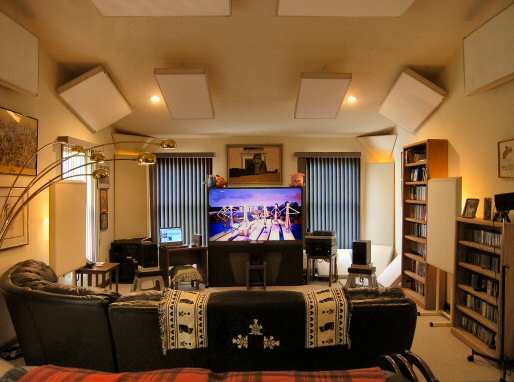jamhead
Well-Known Member
Thanks a lot for the nice comments everyone. The room is coming together, so I am happy with that...
DIYer- A brief description of the side panels. I built a frame using 1x4" pine. The frame was about 3 inches shorter than the panel on all sides. I attached the frame to the wall with a caulking strip behind the frame so that the frame itself was about 1/2" off the wall, but still sealed. Rope light was wrapped around the frame where the caulk strip was and attached to a 3-way lamp table top dimmer, which is touch sensitive. This was simply plugged into an outlet which happened to be behind the panel with the sensor attached to the wall just outside the frame, but covered by the panel. The panel was OC703 with burlap wrapped around it, and I used cardboard on the back to staple the fabric to. We'll see if the fabric will remain tight long term. If not, I'll have to re-wrap and go to plan B (not sure what that is yet).
On the back of the panel, I used Welder compound and glued picture hangers on the back. Then, I hung the panel like a picture. The touch sensor for the lights are behind the panel on the side, so when I turn it on, I simply touch the sensor on the side of the panel. The panel is "floating" off the wall by about 1in or so.
Once I determined where the primary reflection points were..and found they were right on top of outlets (on both sides of the room), I wanted to make use of the outlets and came up with this cheap, simple idea. The time consuming part was getting it all to "fit" together and not be visible.
DIYer- A brief description of the side panels. I built a frame using 1x4" pine. The frame was about 3 inches shorter than the panel on all sides. I attached the frame to the wall with a caulking strip behind the frame so that the frame itself was about 1/2" off the wall, but still sealed. Rope light was wrapped around the frame where the caulk strip was and attached to a 3-way lamp table top dimmer, which is touch sensitive. This was simply plugged into an outlet which happened to be behind the panel with the sensor attached to the wall just outside the frame, but covered by the panel. The panel was OC703 with burlap wrapped around it, and I used cardboard on the back to staple the fabric to. We'll see if the fabric will remain tight long term. If not, I'll have to re-wrap and go to plan B (not sure what that is yet).
On the back of the panel, I used Welder compound and glued picture hangers on the back. Then, I hung the panel like a picture. The touch sensor for the lights are behind the panel on the side, so when I turn it on, I simply touch the sensor on the side of the panel. The panel is "floating" off the wall by about 1in or so.
Once I determined where the primary reflection points were..and found they were right on top of outlets (on both sides of the room), I wanted to make use of the outlets and came up with this cheap, simple idea. The time consuming part was getting it all to "fit" together and not be visible.

